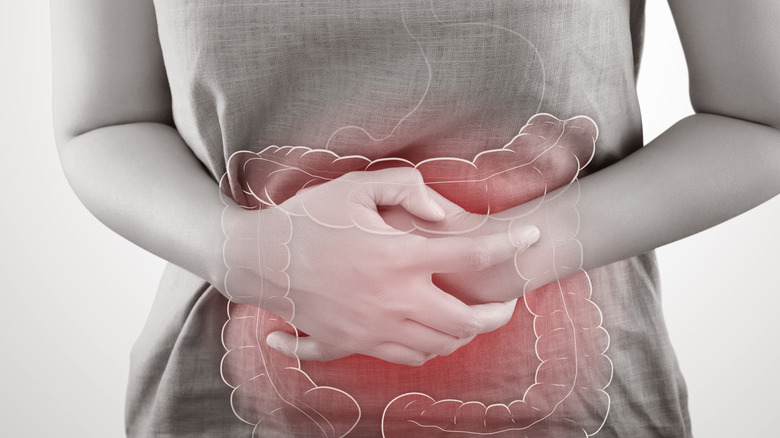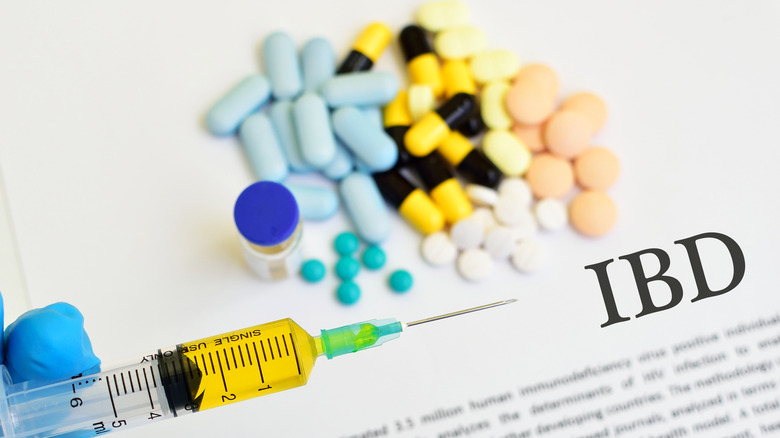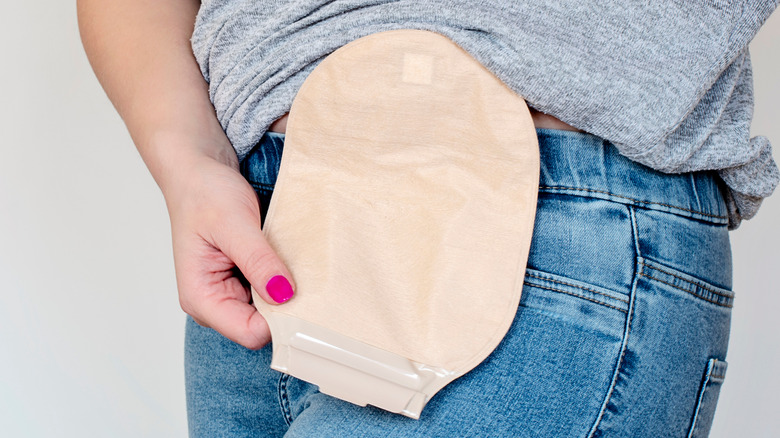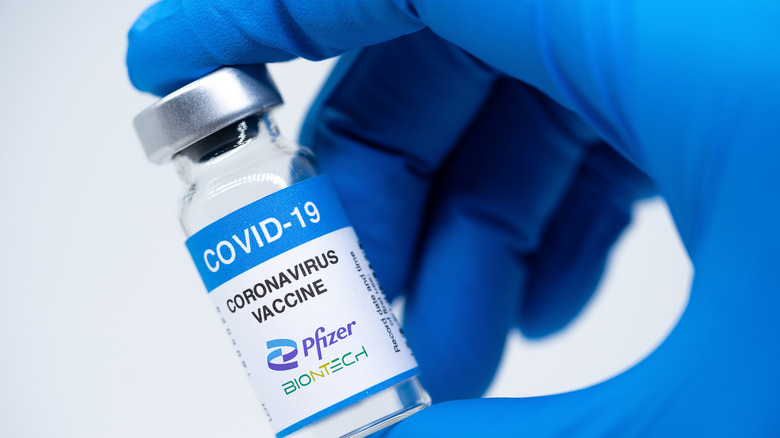IBD Explained: Causes, Symptoms, And Treatments
Inflammatory bowel disease, or IBD, is a term that refers to conditions that are marked by chronic inflammation of the gastrointestinal tract, per the Mayo Clinic. The most common symptoms of IBD include diarrhea, rectal bleeding, abdominal pain, fatigue, and weight loss. Additionally, IBD quadruples the risk for colon (colorectal) cancer.
As described by the Centers for Disease Control and Prevention (CDC), the two main types of IBD are Crohn's disease and ulcerative colitis. Although it can occur in any segment of the GI tract, Crohn's disease most commonly targets the section of the small intestine before the large intestine/colon. Inflamed portions of the gut extend into the deeper intestinal layers and are mixed in with areas of healthy tissue. Meanwhile, ulcerative colitis develops in the large intestine (colon) and rectum. The inflammation affects only the innermost lining, typically beginning in the rectum and progressing to the colon. Unlike Crohn's disease, the damaged segments are continuous and not interrupted by normal tissue.
According to John's Hopkins Medicine, IBD is considered to be an autoimmune disorder wherein the body's immune system mistakenly attacks its own healthy tissues. However, the triggers for IBD have not been identified, and it is not known why only certain people are affected, although people of Jewish ancestry have a higher risk for IBD. IBD is hereditary, but can also occur randomly. It can affect children, particularly teenagers. While there is no cure for IBD, inflammation and symptoms can be reduced.
Difference between IBD and IBS
Since they have similar names and symptoms, IBD is often mixed up with IBS, or irritable bowel syndrome. Though they both involve the gut, these two conditions are quite distinct, reports Johns Hopkins Medicine. IBS is not inflammatory; rather, it is characterized by alternating periods of diarrhea and constipation. This may be linked to overly sensitive nerves in thegut that cause abnormal movements of food and fluid through the digestive tract.
According to the Cleveland Clinic, IBS — sometimes referred to as spastic colon or nervous stomach — has less severe symptoms than IBD. Unlike IBD, IBS is not associated with damage to the intestines nor a heightened risk of colon cancer. Moreover, with IBS, the need for hospitalization or surgery is unlikely.
While it is possible to have both conditions, the risk for people with IBS to develop IBD is not supported by any research evidence.
Prevalence of IBD
As determined by a 2021 systematic analysis published in The Lancet Gastroenterology & Hematology, the prevalence of IBD increased substantially in nearly 200 countries and territories from 1990 to 2017. The researchers report that the global prevalence of IBD is currently (as of 2021) close to 4 million among the female population and nearly 3 million among males, and these numbers continue to rise.
IBD is more prevalent among people with higher socioeconomic status. This may be related to better diagnostic testing and/or delayed or reduced childhood exposure to common infectious microbes, resulting in an altered immune response in children genetically predisposed to IBD. Since IBD is generally a lifelong condition with high disability, much of the social costs include early retirement, sick leave, and other indirect costs. Thus, notes the researchers, IBD has a considerable impact on healthcare systems, as well as the overall economy.
Consistent with the findings of the recent systematic analysis above, IBD is more common to industrialized nations, per a report published via StatPearls. Accordingly, North America and Europe have a significantly higher prevalence of IBD than Asia and Africa. Ulcerative colitis tends to be equally distributed between males and females, whereas Crohn's disease is more commonly observed in females versus males.
Symptoms and complications of IBD
IBD generally goes through phases, reports WebMD. When it flares up, IBD patients experience mild to severe symptoms; when IBD is in remission, symptoms are reduced or disappear. Among the most common symptoms are abdominal pain and cramps, diarrhea (sometimes bloody), severe bowel urgency, fever, weight loss, loss of appetite, and blood loss resulting in iron deficiency anemia.
Per Johns Hopkins Medicine, inflammation may cause swelling or masses in the gut. Unchecked, inflammation may lead to intestinal damage, causing abscesses (sections of infection that can damage the intestinal wall) or strictures (bowel narrowing). In addition, inflammation and pressure within the bowel may cause tissue to degrade and result in the formation of a fistula, which allows intestinal contents to leak into the bladder, vagina, or urethra. Chronic inflammation in the colon is associated with an elevated risk of colon cancer.
Beyond the gastrointestinal tract, other parts of the body may be affected as well. Approximately 10% to 43% of people with IBD may experience redness and inflammation in the eyes, whereas other may develop mouth problems (e.g., stomatitis, mouth sores, and ulcers). The skin may become tender with red bumps on the shins and, though rare, severe skin ulcers can develop on the legs. Blood vessel inflammation, joint inflammation near the base of the spine, arthritis in the extremities, and stress fractures of the vertebrae may also occur with IBD. Finally, IBD has been linked to gallstones, kidney stones, urinary tract infections, and fatty liver.
Causes and risk factors
As reported by WebMD, IBD results from an interplay between genetic, immune, and environmental factors. A single environmental trigger or combination of triggers (e.g., viruses, bacteria, or antigens), activates an inflammatory immune response in the gut. Since roughly 20% of people with IBD have a family history of the disease, genetics appears to play a role as well. Indeed, since 2006, scientists have identified over 200 regions of the human genome associated with IBD risk.
While most people who develop IBD are 15 to 30 years old, a second spike in IBD occurs in people over age 60 (via Medical News Today). Other risk factors include the use of nonsteroidal anti-inflammatory drugs (NSAIDs), birth control, and antibiotics. A higher risk of ulcerative colitis, specifically, is associated with people of Jewish heritage. Similarly, smoking is strongly tied to Crohn's disease, doubling the risk.
The cause of IBD is not fully understood (via ScienceDirect). Evidence suggests that the microbiota (the normal intestinal flora) inappropriately trigger an immune response in the gut that causes severe collateral damage to the intestinal lining. People with a genetic predisposition to IBD are more likely to develop this abnormal immune response. That said, the microbiota may be considered a human organ; in this regard, IBD can be seen as an autoimmune disorder. In autoimmune diseases, the immune system is unable to distinguish between the body's own cells and foreign cells, whereupon the body attacks and damages its own cells by mistake.
Diagnosis of IBD
Before a diagnosis of IBD can be made, other possible causes of inflammation must be ruled out, according to the Merck Manual. For example, bacterial or parasitic infections (e.g., antibiotic-induced Clostridioides difficile infection), which may trigger inflammation, can be spotted from stool samples. Other tests may be used to exclude various sexually transmitted disease such as gonorrhea and genital herpes. Consideration is also given to conditions that exhibit similar abdominal symptoms to IBD, including IBS, ischemic colitis, and celiac disease.
Barium studies are performed to draw a distinction between ulcerative colitis and Crohn's disease (via StatPearls). If the rectum is unaffected, Crohn's disease is indicated. Skip lesions and stricture formation in the ileum are also suggestive of Crohn's disease. In contrast, a "lead pipe appearance" points to ulcerative colitis. Abdominal X-rays are useful for detecting bowel obstruction, free air in the gut, or toxic megacolon. Other imaging studies used to diagnose IBD and evaluate complications include ultrasound (US), computerized tomography (CT), and magnetic resonance imaging (MRI). Biopsies obtained from endoscopy procedures (e.g., colonoscopy) are used to confirm an IBD diagnosis.
Nonsurgical medical treatments for IBD
Per WebMD, the goals of medical treatment for IBD are to heal intestinal inflammation to reduce symptoms, stop future flare-ups, and achieve and maintain remission. Initially, doctors often prescribe milder drugs such as aspirin-like anti-inflammatory medications. More potent corticosteroids (NSAIDs) may then be used to quell more persistent inflammation and symptoms. If steroids do not provide sufficient relief, the next-in-line treatment is immunosuppressive drugs, which inhibit the release of inflammation-inducing chemicals from the immune system. Since these drugs may take effect only after 2 to 3 months of use, they are not indicated for severe flare-ups.
Biologics are high-level therapies for more severe cases of IBD. These treatments (e.g., Remicade, Humira) are essentially antibodies that neutralize other proteins in the body that fuel inflammation. For example, Remicade blocks TNF-alpha, a proinflammatory cytokine produced by immune cells that may trigger the tissue damage associated with Crohn's disease. Clinical trials involving new treatments are an option for IBD patients who do not improve with drug therapies.
At times, additional drugs and supplements may be recommended for specific symptoms, reports the Mayo Clinic. Antibiotics (e.g., Cipro) may be indicated for infections while anti-diarrheal medications (e.g., Imodium A-D) or fiber supplements such as Metamucil can help alleviate mild to moderate diarrhea. Acetaminophen (e.g., Tylenol) is the drug of choice for pain relief, as opposed to ibuprofen, naproxen, and diclofenac (which can all worsen the disease). Finally, vitamins and other supplements may be suggested when malabsorption is an issue.
Surgical treatments for IBD
According to Johns Hopkins Medicine, roughly half of people with IBD may require surgery at some point. This is particularly the case for those individuals who do not respond well to medications and thus develop intestinal damage from unchecked inflammation. These diseased regions of the digestive tract may need to be removed, though surgeons try to keep enough of the intestines intact in order to maintain sufficient nutrient absorption.
In severe cases of ulcerative colitis (via the Mayo Clinic), the whole colon and rectum may need to be removed, followed by the creation of an "internal pouch" linking the anus with the small intestine. As a result, the patient can continue to have bowel movements without the need for a bag. However, in some people with IBD, a surgically created opening is made in the abdomen (called an ileal stoma) to divert waste into an attached bag.
In Crohn's disease, surgery can provide temporary benefits but no cure. Typically, diseased segments of the intestines are removed and healthy portions are reconnected. Since the rate of recurrence of Crohn's disease is high, follow-up treatment with medication is recommended to lessen the chances of the disease returning.
IBD diet
As reported by WebMD, diet modification mat help improve symptoms of IBD. A low-residue (i.e., low fiber) diet is frequently recommended to alleviate symptoms of diarrhea and abdominal pain. Since this is a very restrictive diet, supplementation with vitamins may be suggested to prevent nutrient deficiencies. Eating small, frequent meals and minimizing dairy products may ease IBD symptoms as well.
Increasing consumption of oily fish and other foods rich in omega-3 fatty acids and cutting back on processed foods high in omega-6 fats may help suppress inflammation and enhance the gut microbiota (via Johns Hopkins Medicine). Some people with IBD note that they feel better when avoiding gluten, the protein in wheat, rye, and barley. They also report less bloating, cramping, and fatigue on the gluten-free diet. Evidence from some studies supports the use of a diet low in FODMAP to calm IBD symptoms. FODMAP is an acronym that denotes specific carbohydrates (sugars) that are poorly absorbed and digested, resulting in IBD-like symptoms such as gas, bloating, and flatulence. Notably, sorbitol and other sugar-alcohol sweeteners are disallowed on the low FODMAP diet, as they are particularly notorious for aggravating diarrhea. Finally, alcohol and caffeine can potentially provoke IBD symptoms, and may need to be restricted.
IBD and vaccines
As explained in a clinical practice guideline published in a 2021 edition of Gastroenterology, people with IBD are more susceptible to vaccine-preventable infectious diseases because of an inherently weakened immune system, which is greatly exacerbated with immunosuppressive medications. Therefore, getting appropriate vaccines regularly is vital for people with IBD. However, while live vaccines are generally recommended for people who are not receiving immunosuppressive therapy, they are not advised for those patients being treated with immunosuppressive drugs. According to the guideline, live vaccines (e.g., Bacillus Calmette-Guérin, chickenpox, and smallpox) can trigger disease via unchecked viral replication.
With regard to inactivated vaccines, people with IBD should be inoculated yearly with the influenza vaccine and the pneumococcal vaccine, reports the Merck Manual. Those who are 50 years of age and older should get the herpes zoster (shingles) vaccine, preferably before commencing immunomodulating therapies. People under the age of 50 may also receive the shingles vaccine, but only after consulting with their physician to determine whether the vaccine is necessary. If appropriate, routine vaccinations — tetanus-diphtheria, hepatitis A, hepatitis B, human papillomavirus — should be maintained as well.
Per the Centers for Disease Control and Prevention (CDC) as well as the Canadian Association of Gastroenterology, an mRNA Covid-19 vaccine is recommended for people with IBD, including those undergoing treatment with immunosuppressive drugs (via the Merck Manual).
IBD and risk of colorectal cancer
Per a 2018 review in Clinics in Colon and Rectal Surgery, the risk of colorectal (or colon) cancer (CRC) is substantially increased (up to four times) in people diagnosed with IBD before the age of 30. Thus, the longer the disease duration, the greater the risk of CRC.
Other risk factors for IBD-related CRC include the extent and severity of IBD. For example, increasing length of affected colon increases the risk of CRC; conversely, disease affecting short segments of colon do not increase CRC risk. The degree of inflammation is linked to the risk of cancer as well. Pseudopolyps signify previous severe inflammation and healed damage to the inner lining of the gut. Their presence doubles the risk of CRC within the diseased area. Lastly, a family history of colorectal cancer independently increases CRC risk in IBD patients.
An article published in a 2021 edition of Frontiers in Pharmacology discussed the contribution of the gut microbiota to CRC risk in IBD patients. There is widespread agreement that gut microbes communicate with the innate immune system and stimulate immune responses. The gut microbiota of IBD patients with CRC is marked by the overgrowth of certain species of bacteria that play a role in the development of IBD and CRC. The use of probiotics to increase levels of favorable bacteria could restore balance to the microbiota and potentially improve the IBD-CRC condition. A key benefit of greater amounts of beneficial bacteria is their production of short-chain fatty acids (SCFAs), which possess anti-inflammatory properties.
Prognosis for people with IBD
While life expectancy among people with IBD increased from 1996 to 2011, it is, nevertheless, still lower than the life expectancy of people without IBD, concludes a 2020 study published in the Canadian Medical Association Journal. The gap in life expectancy between people with and without IBD peaked at 8.1 years for females and 6.1 years for males. The difference in health-adjusted life expectancy, or healthspan, between the two groups was even greater. The researchers determined that this was predominantly due to a significant effect of pain on compromising daily functioning. For example, abdominal pain may persist even during remission and is often neglected by healthcare professionals. In addition, pain-related comorbidities and joint disorders are especially prevalent among females with IBD.
Causes of death among people with IBD include the disease itself, infections, and respiratory illness (via StatPearls). Anxiety and depression are very common in IBD patients relative to the public at large, contributing to the poor quality of life characteristic of IBD. Lastly, the extent of disease and the treatment response are also key determinants with regard to the prognosis for IBD.












